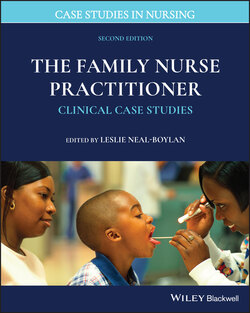Читать книгу The Family Nurse Practitioner - Группа авторов - Страница 62
ОглавлениеCase 6.9 Urinary Frequency
By Leslie Neal‐Boylan, PhD, APRN, CRRN, FAAN, FARN
SUBJECTIVE
Susan is a 42‐year‐old female who presents with a report of burning pain on urination for the past 2 days. She has been urinating frequently and finds that she has to run to make it to the bathroom in time to void in the toilet. She vaguely remembers similar symptoms once in college but doesn’t remember what she was diagnosed with or how she was treated for it. She denies flank pain but does have some mild suprapubic pain. She admits to mild dyspareunia in the past few days. Susan is otherwise well but admits to being thirsty more frequently than usual. Her menses are regular, and her LNMP was 10 days ago. She denies vaginal itching, foul odor, or discharge. Her 2 children were born via vaginal deliveries without complications. She does not recall when she last had a pelvic exam or Pap smear and recalls a remote history of an abnormal Pap smear. She thinks she had a colposcopy at that time and after 1 year, she was told to resume a normal Pap smear schedule.
Social history: Susan is a recently divorced mother of 2 young children. Her ex‐husband was “fooling around” while they were married, so Susan is worried that she might have a sexually transmitted infection. Since the divorce, Susan has had 1 new male sexual partner. They began their sexual relationship about 1 week ago and did not use condoms because Susan was on birth control pills and “I trust this new man.” She works full‐time as a preschool teacher and takes care of her children, ages 12 and 15, by herself and without financial support from her ex‐husband. Susan does not smoke but has an occasional (1 per month) glass of wine. She admits to having used marijuana in college.
Family medical history: Notable for diabetes Type 2 (mother) and hypertension (father).
Medications: Birth control pills.
OBJECTIVE
General: The patient is in no acute distress and is pleasant and cooperative.
Vital signs: Oral temperature is 98°F. BP is 116/74. HR is 64 and regular.
Respiratory: Respirations are 14 and regular. Lungs are clear bilaterally.
Back: There is no CVAT.
Cardiac: RRR S1/S2; without murmurs, clicks, gallops, or rubs.
Abdomen: Soft, nontender, nondistended, without organomegaly. Bowel sounds are active in all 4 quadrants.
Reproductive: Pelvic exam reveals no inguinal lymphadenopathy; moist pink vaginal mucosa, negative chandelier sign, and pink anterior cervix without friability. Cervical discharge is thin, white, and odorless. Samples are obtained for culture. This patient could also have provided a urine sample to test for gonorrhea and chlamydia. However, given her history with a new partner and an ex‐husband who had other partners, as well as the length of time since her last pelvic exam, it is reasonable to do a pelvic exam at this time. A Pap smear is also performed because Susan cannot recall when she last had one and there is none noted in the electronic record. The test will include HPV testing. The bimanual exam reveals no masses or tenderness.
CRITICAL THINKING
1 What is the most likely differential diagnosis and why?__Pregnancy__Acute cystitis__Interstitial cystitis__Diabetes mellitus__Pyelonephritis__Pelvic inflammatory disease__Urinary tract infection (UTI)
2 Which diagnostic studies should be considered to assist with or confirm the diagnosis?__Urine dipstick__Urinalysis__Urine culture and sensitivity__CBC__CMP__TSH__Renal ultrasound__Abdominal and pelvic ultrasound
3 What is the plan of treatment?
4 What is the plan for referrals and follow‐up?
5 Would the diagnosis change if the patient had fever and flank pain?
6 Would the most likely diagnosis change if the patient were male?
7 What is an important symptom to consider in an older adult?
8 What if Susan were pregnant?
